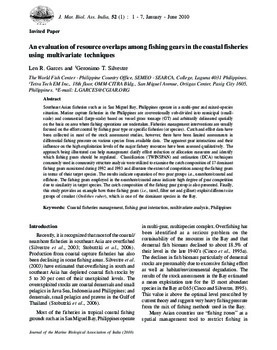An evaluation of resource overlaps among fishing gears in the coastal fisheries using multivariate techniques

Citation
Garces, L.R.; Silvestre, G.T. (2010). An evaluation of resource overlaps among fishing gears in the coastal fisheries using multivariate techniques. Journal of the Marine Biological Association of India 52(1): 1-7
Southeast Asian fisheries such as in San Miguel Bay, Philippines operate in a multi-gear and mixed-species situation. Marine capture fisheries in the Philippines are conventionally sub-divided into municipal (small-scale) and commercial (large-scale) based on vessel gross tonnage (GT) and arbitrarily delineated spatially on the basis on area where fishing operations are undertaken. Fisheries management interventions are usually focused on the effort control by fishing gear type or specific fisheries (or species). Catch and effort data have been collected in most of the stock assessment studies, however, there have been limited assessments in differential fishing pressure on various species from available data. The apparent gear interactions and their influence on the high exploitation levels of the major fishery resources have been assessed qualitatively. The approach being illustrated can help management clarify effort reduction or allocation measures and identify which fishing gears should be regulated. Classification (TWINSPAN) and ordination (DCA) techniques commonly used in community structure analysis were utilized to examine the catch composition of 17 dominant fishing gears monitored during 1992 and 1993 and illustrate the extent of competition among the fishing gears in terms of their target species. The results indicate separation of two gear groups i.e., nearshore/coastal and offshore. The fishing gears employed in the nearshore/coastal areas indicate high degree of gear competition due to similarity in target species. The catch composition of the fishing gear group is also presented. Finally, this study provides an example how three fishing gears (i.e., trawl, filter net and gillnet) exploit different size groups of croaker (Otolithes ruber), which is one of the dominant species in the Bay.
Permalink
Date Available
Type
Publisher
Countries
ISSN
0025-3146
Research Themes
Language